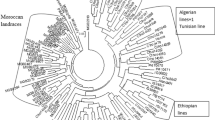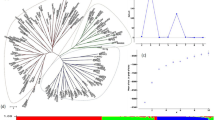Summary
A random sample of 463 accessions of cultivated barley from the Tibet Hordeum germplasm collection was assayed electorphoretically for genetic diversity at six isozyme loci. Two loci (Acp-1 and Got-1) were found to be monomorphic and extensive variation was detected at the remaining four loci (Est-1, Est-2, Est-3 and Est-4). The allelic composition of Tibetan barley appeared to be distinct as compared to the results of previous studies of barleys from other parts of the world. Partitioning of genetic diversity showed that approximately 96% of the total variation was maintained at the within-subregion level and only about 4% was accounted for by differentiation among the eight subregions. Analysis of multilocus genotypes revealed non-random association of the alleles at the four loci, both in the entire sample and in all the subregions, although the four major multilocus genotypes did not show significant departure from the expectation based on complete random association. The possible causes for the establishment of these multilocus associations were discussed.
Similar content being viewed by others
References
Åberg E (1938) Hordeum agriocrithon, a wild six-rowed barley. Ann Agric Sweden 6:159–216
Åberg E, Weibe GA (1945) Irregular barley, Hordeum irregulare, sp. nov. J Wash Acad Sci 35:161–164
Allard RW (1988) Genetic changes associated with the evolution of adaptedness in cultivated plants and their wild progenitors. J Hered 79:225–238
Brücher H, Åberg E (1950) Die Primitivgersten des Hochlandes von Tibet, ihre Bedeutung für die Zuechtung und das Verstaendnis des Ursprungs und der Klassifizierung der Gersten. Ann Agric Coll Sweden 17:247–319
Chen H, Ni Z, Sun S, Yu X, Chen D (1984) Agricultural geography of Tibet (in Chinese). Academic Press, Beijing
Fresleben R (1943) Ein neuer Fund von Hordeum agriocrithon Åberg, Zuechter 16:49–63
Kahler AL, Allard RW (1970) Genetics of isozyme variants in barley. I. Esterases. Crop Sci 10:444–448
Kahler AL, Allard RW (1981) Worldwide patterns of genetic variation among four esterase loci in barley (Hordeum vulgare L.). Theor Appl Genet 59:101–111
Kahler AL, Heath-Pagliuso S, Allard RW (1981) Genetics of isozyme variants in barley. II. 6-phosphogluconate dehydrogenase, glutamate oxalate transaminase and acid phosphatase. Crop Sci 21:536–540
Nei M (1972) Genetic distance between populations. Am Nat 106:283–292
Schiemann E (1951) Neue Gerstenformen aus Ost-Tibet und ein weiterer Fund von Hordeum agriocrithon Åberg. Ber Dtsch Bot Ges 64:57–69
Shao Q (1981) The evolution of cultivated barley. In: Asher MJC, Ellis RP, Hayter AM, Whitehouse RNH (eds) Barley genetics IV. Edinburgh Univ. Press, pp 22–25
Takahashi R (1955) The origin and evolution of cultivated barley. Adv Genet 7:227–266
Takahashi R (1964) Further studies on the phylogenetic differentiation of cultivated barley. In: Broekhuizen S, Dantuma G, Lamberts H, Lange IW (eds) Barley genetics I. Center Agric Publication Documentation, Wageningen, pp 19–26
Weir BS, Allard RW, Kahler AL (1972) Analysis of complex allozyme polymorphisms in a barley population. Genetics 72:502–523
Weir BS, Allard RW, Kahler AL (1974) Further analysis of complex allozyme polymorphisms in a barley population. Genetics 78:911–919
Xu T (1982) Origin and evolution of cultivated barley in China. Acta Genet Sin 9:440–446 (in Chinese with English abstract)
Yao Z (1982) Studies on the N-banding kayotypes of cultivated and wild barley. Acta Genet Sin 9:160–164 (in Chinese with English abstract)
Zhou Z, Shao Q, Zhou Z (1983) Analyses on karyotype and esterase isozyme of cultivated and wild barleys from Qinghai-Xizang (Tibet) plateau. Acta Genet Sin 10:203–208 (in Chinese with English abstract)
Author information
Authors and Affiliations
Additional information
Communicated by P.M.A. Tigerstedt
Rights and permissions
About this article
Cite this article
Dai, X., Zhang, Q. Genetic diversity of six isozyme loci in cultivated barley of Tibet. Theoret. Appl. Genetics 78, 281–286 (1989). https://doi.org/10.1007/BF00288812
Received:
Accepted:
Issue Date:
DOI: https://doi.org/10.1007/BF00288812




